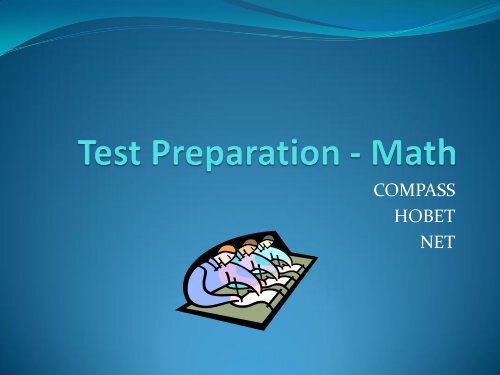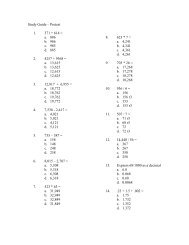Math PowerPoint
Math PowerPoint
Math PowerPoint
- No tags were found...
Create successful ePaper yourself
Turn your PDF publications into a flip-book with our unique Google optimized e-Paper software.
COMPASSHOBETNET
Top 10 Test Taking Strategies10. Read all directions and questions carefully9. Attempt every question – it may not be as difficult asit appears8. Anticipate the answer – if it isn’t there, test the otheranswers7. Use logical reasoning –can the answer you came up withbe the correct answer?
Top 10 Test Taking Strategies6. Use the practice tests as a study guide5. Keep a positive attitude. Don’t go into the testthinking you will fail4. Keep your tension under control and try toconcentrate on points that youwish to remember3. Make sure you are ready to sitdown and concentrate on the test
Top 10 Test Taking Strategies2. Select your answer and then re-read the question tomake sure that you understood it correctly1. Relax! Keep calm. And do your best!
Structure of the COMPASS Test• The test is not timed• The computer will generate the questions individually• The English essays contain many errors inpunctuation, grammar, and style.• Carefully read the essays• When you locate an error, choosethe best option for rewriting the essay.
Structure of NET/HOBET Test• Evaluates• Reading Comprehension• Written Expression• Basic <strong>Math</strong>• Learning Styles• Multiple Choice Questions• Look for the “best” answer
Structure of NET/HOBET Test• Number of Questions• 25 to 35 reading comprehension• 30 math problems• 45 decisions statements• 30 test taking skills• Time Limits• COMPASS is not timed• NET/HOBET is a 2.5 hour timed test
Purpose of the Entrance Test• There are minimum requirements for entrance in toSoutheast – do your best!• The entrance test will establish your needs in acollegiate setting.• The test is designed to identify needs so that they maybe addressed before theybecome an issue.• The learning style assessment willbe used only for counseling.
<strong>Math</strong>ematics• ASSUMPTION: This class assumes that you know howto add, subtract, multiple and divide whole numbers• If you need additional help in this area, drill with themultiplication tables and division facts!
COMPASSHOBETNET
Numerator & Denominator• Numerator – top part of the fraction & indicates howmany parts are being counted• Denominator – bottom part of a fraction & indicates howmany parts the whole is dividedEach slice = 1/8 Each slice = 1/4 Each slice = 1/2
Fractions• The denominator indicates how many partsa whole thing is divided into• Slice two pizzas, one into 8 slices and oneinto 4 slices. Which pizza would have thelarger slices?• A larger denominator indicates that thereare more pieces of the whole.Hence each piece must be smaller.
Proper & Improper Fractions• If the numerator is less than the denominator, thefraction is a proper fraction and is less than 1• 1/3 < 1 7/20 < 1• If the numerator is greater than the denominator, thefraction is an improper fraction and is greater than 1• 3/2 > 1 8/3 > 1• If the numerator and denominator are the same,the fraction is equal to 1• 5/5 = 1 10/10 = 1
Simplify an Improper Fraction• Divide the numerator by the denominator• The quotient is the whole number part.• The remainder is the numerator of the fractional part.• The denominator is the same as one in the originalfraction.
COMPASSHOBETNET
Change a Mixed Number to an Improper Fraction• A mixed number is the sum of an integer and a properfraction• 2 3/5 is the sum of 2 and 3/5• 1 + 1 + 3/5 or 5/5 + 5/5 + 3/5 or (5 + 5 + 3)/5 or 13/5
Change a Mixed Number to an Improper Fraction (Cont.)• To change 2 3/5 to an improper fraction, multiply thewhole number by the denominator• Then add the numerator. Place the result over thedenominator.
COMPASSHOBETNET
Equivalent Fractions• Equivalent Fractions have the same value
Equivalent Fractions• You can multiply or divide the numerator and denominatorof a fraction by the same number to get an equivalentfraction
Find the Equivalent Fractions
Ratio & Proportions•A ratio is a comparison of one numberto another•A proportion is an equality of tworatios•The expression “2 is to 4 as 10 is to 20”is the same as the following• 2:4::10:20• 2/4 = 10/20
Equivalent Fractions, Ratios, & Proportions
Which fractions are equivalent?
Simplify (Reduce) Fractions• Divide the numerator and the denominator by a commonfactor or the largest number that evenly divides both thenumerator and the denominator
Combine “Like” Fractions• “Like” fractions have the same denominator• Add or subtract the numerators and place the sum ordifference over the denominator• Reduce the fraction, if possible
Combining “Unlike” Fractions• “Unlike” fractions have different denominators• Find a common denominator or the Least CommonMultiple of the denominators• Express each fraction as an equivalent fraction with acommon denominator• A common denominator is the product of the denominators,although it may not be the smallest common denominator• Add or subtract the numerators and place the sum ordifference over the denominator• Reduce the fraction
Combine “Unlike” Fractions
Another Example
Another Example
Combine Mixed Numbers• Find the Least Common Denominator (LCD)• Find the equivalent fractions• Add or subtract the fractions and add or subtract thewhole numbers• Simplify your answer
COMPASSHOBETNET
Multiply Fractions• Simplify the fractions if not in lowest terms• Multiply the numerators of the fractions to get the newnumerator• Multiply the denominators of the fractions to get thenew denominator• Simplify the resulting fractionProblem:Solution:
Example – 2 Different Methods
Multiplying with Mixed Numbers• Change each number to an improper fraction• Simplify if possible• Multiply the numerators and then the denominators• Put the answer in lowest terms
COMPASSHOBETNET
Decimal Place Values• Numbers to the right of the decimal point have a value less than 1• Numbers to the left of the decimal point have a value greaterthan 1
Rounding Decimals• Look at the digit to the right of the place you wish to round to.• When the digit is 5, 6, 7, 8, or 9, round up• When the digit is 0, 1, 2, 3, or 4, round down
COMPASSHOBETNET
Add or Subtract Decimal Numbers• Put the numbers in a vertical column aligning the decimalpoints and adding O’s at the end of any number as needed• Add or subtract the numbers• Place the decimal point in the answer directly below thedecimal points in the column
Decimals• Line up the numbers on the right – do not align thedecimal points• Multiply the numbers just as if they were wholenumbers• Place the decimal point in the answer by starting at theright and moving a number of places equal to the sumof the decimal places in both numbers
Dividing Decimal Numbers• If the divisor is not a whole number, move the decimalpoint to the right to make it a whole number• Move the decimal point in the dividend the samenumber of places
Dividing Decimal Numbers (Cont.)• Divide as usual until the answer terminates or repeats
Dividing Decimal Numbers (Cont.)• Put the decimal point in the answer directly above thedecimal point in the dividend• Check your answer by multiplying the quotient by thedivisor. Do you get the dividend?
Examples of Division with Decimals
Divide a Decimal Number by a Power of 10• Move the decimal point to the left as there are zeros in thedivisor
COMPASSHOBETNET
Convert a Fraction into a Decimal Number• Divide the numerator (top number) by the denominator(bottom number)
Convert a Decimal Numberto a Fraction• Read the numerical decimal, paying close attention tothe ending• Place the number in the decimal, written as a wholenumber, in the numerator of the fraction• Take the ‘ths’ off the ending read in step 1 and placethe numeric value of the number in the denominator
COMPASSHOBETNET
Percentages• Percent means ‘per 100’ and is written with the symbol %
A Percent Can Be Expressedas a Fraction or a Decimal
Convert a Percent to a Fraction• Drop the % symbol• Divide the number by 100• Simplify the fraction
Another Example
Convert a Percent to a Decimal20% = 20/100 = .20 = .2½% = .5/100 = .00520 ½% = 20.5/100 = .2052.4% = 2.4/100 = .024
Convert a Fraction to a Percent• Multiply both numerator and denominator by a numberto make the denominator equal to 100• Write down the numerator followed by ‘%’
Convert a Percent to a Decimal• Drop the % symbol• Divide by 100 by moving the decimalpoint two places to the left• Add zeros as needed
Convert a Decimal Number to a Percent• Multiple by 100 by moving the decimal pointtwo places to the right• Add zeros as needed• Add percent symbol
Ratios and Proportions• A ratio is a relationship between two quantities expressedas a fraction or with a colon• The ratio of 1 to 2 can be written as ½ or 1:2• A proportion is the equality of two ratios• 1:3 :: 2:6• 1/3 : 2/6
Solve for X in a Proportion4x = 12x = 3Product of the Meansequals the product of theExtremes
Percentage Problems• ‘Of’ means multiply and ‘Is’ means equals
COMPASSHOBETNET
Solve for the Unknown• 75 milligrams of Demerol is prescribed for a patient followingsurgery. The medication is available as a liquid solution, with 1milliliter of solution containing 100 milligrams of Demerol. Toadminister the prescribed dose of 75 milligrams, X milliliters ofthe solution would be given.100 mg Demerol: 1 ml Solution :: 75 mg Demerol: X mlsolution100 mg/1 ml = 75 mg/X ml100 mg * X ml = 75 mg * 1 ml100 X = 75X ml= 75/100 = ¾
Addition Axiom (Truth)• You add or subtract the same number or expression to eachside of an equation• X – 15 = 30• X – 15 + 15 = 30 + 15• X = 45• Practice:• W – 4 = 8• M – 12 = 14• Y – 9 = 21
Subtraction Axiom (Truth)• You can subtract the same number or expression from eachside of an equation• 3 + x = 12• 3 – 3 + x = 12 – 3• x = 9• Practice• 5 + g = 20• 21 + w = 45• S + 3 = 19
Multiplication Axiom (Truth)• You can multiply each side of an equation by the samenumber or expression• x/3 = 12• x/3 * 3 = 12 * 3• x = 36• Practice• x/4 = 5• x/3 = 3• x/2 = 50
Division Axiom (Truth)• You can divide each side of an equation by the samenumber or expression• 3x = 12• 3x/3 = 12/3• x = 4• Practice• 5x = 20• 2w = 16• 4y = 28
COMPASSHOBETNET
Multiplying Signed Numbers• A negative number times a negative number equals apositive number• -3 * -4 = +12• A positive number times a positive number equals apositive number• +9 * +11 = +99• A negative number times a positivenumber equals a negative number• +6 * - 5 = -30
Dividing Signed Numbers• A negative number divided by a negative numberequals a positive number• -8/-2 = 4• A positive number divided by a positive number equalsa positive number• +18/+9 = +2• A negative number divided by a positive numberequals a negative number• -14/7 = -2• A positive number divided by a negative numberequals a negative number• +24/-3 = -8
Adding Two Numbers with ‘Like’ Signs• Add the numbers and give the answer the same sign• (+10) + (+15) = +25• (-10) + (-15) = -25
Adding Two Numbers with ‘Unlike’ Signs• Subtract the two numbers and give the sign of thenumber with the larger absolute value• (-10) + (+6) = -4• (+10) + (-6) = +4• (-10) +(+7) = -3• (+10) + (-7) = +3
Subtracting Signed Numbers• Change the sign of the second number then follow therules for addition• -14 – (-9) = -14 + (+9) = -5• -15 – (+8) = -15 + (-8) = -23• +22 - +12 = +22 + (-12) = 10• -14 – (-20) = -14 + (+20) = +6
Order of Operations• If there are roots or powers in any term, you may be ableto simplify the term by using the laws of exponents• 5xy(3x 2 y)=15x 3 y 2• Perform operations in parentheses• Perform multiplication and division in order from left toright before addition or subtraction
Commutative Property• The order in which you multiply does not matter• 6xy is the same as 6yx• The order in which you add terms does not matter• a + b is the same as b + a
Distributive Property• 2(a + b) = 2a + 2b• 3(2 + c) = 3 * 2 + 3c = 6 + 3c• 2x(y+3) = 2xy+ 2x(3)= 2xy + 6x
Simplifying Algebraic Expressions• Combine like (similar) terms• Like terms would be –x, 2x, 5x• 6x – 2x + x + y• (6-2+1)x +y• 5x + y
Simplifying Algebraic Expressions• If an expression has more than one set of parentheses,work on the inner parentheses first and then work outthrough the rest of the parentheses• 2x – (x+6(x-3)) + y• 2x – (x +6(x) + 6(-3)) + y• 2x – (x + 6x -18) + y• 2x – (7x - 18) + y• 2x + (-1)(7x) + (-1)(-18) + y• 2x – 7x + 18 + y• -5x + y + 18
Adding and SubtractingAlgebraic Expressions• Like terms in algebraic expressions can be added andsubtracted• (3x + 4y – xy) + 2(3x-2y)• (3x + 4y – xy) + 6x - 4y• (3x + 6x) + (4y – 4y) –xy• 9x + 0 – xy• 9x - xy
Multiplying Binomials• Multiply each term of the first expression by each termof the second expression• FOIL = First times First, Outer times Outer,Inner times Inner, Last times Last• (b-4)(b+a)• b(b+a) -4(b+a)• b2 + ab – 4b – 4a
Equations• An equation is a statement that says two algebraicexpressions are equal• Order of operations (MDAS = My Dear Aunt Sally)• Exponentiation• Parentheses• Multiply or Divide in order from left to right• Addition or Subtraction in order from leftto right• Subtraction
Equivalence In AlgebraicExpressions• Transform a given equation into an equivalentequation whose solutions are obvious• Group all terms that involve the unknown on one sideof the equation and all numbers on the other side(isolating the unknown)• Combine like terms on each side• Divide each side by the coefficientof the unknown
Solve Algebraic Expressions• 6x + 2 = 3• 6x + 2 – 2 = 3 -2• 6x = 1• x = 1/6• 5x + 3 = 2x - 9• 5x + 3 – 3 = 2x – 9 – 3• 5x – 2x = 2x – 2x – 12• 3x = -12• x = -12/3 = -4
Algebra - COMPASS• Parallel lines have equal slopes• Square roots• Exponents• Mixtures and percentages• Factoring of polynomials• Parabolas
Practice Hobbit or Compass Testhttp://www.testprepreview.com/hobet_practice.htmhttp://www.testprepreview.com/compass_practice.htm• Self Assessment Modules• Basic Algebra• Advanced Algebra• Averages & Rounding• Arithmetic• Commas• Estimation & Sequences• Fractions & Square Roots• Geometry• Basic Grammar• Intermediate Grammar• Advanced Grammar
Mixture ProblemSuppose you work in a lab. You need a 15% acid solutionfor a certain test, but your supplier only ships a 10%solution and a 30% solution. Rather than pay the heftysurcharge to have the supplier make a 15% solution, youdecide to mix 10% solution with 30% solution, to makeyour own 15% solution. You need 10 liters of the 15% acidsolution. How many liters of 10% solution and 30%solution should you use?
Set Up Your VariablesLiterssolution% acid Total litersacid10% solution X .10 .10 x30% solution Y .30 .30yMixture X+Y= 10 .15 .10 x + .30 ySince x + y = 10, then x = 10 – y. Using this, we can substitute for x inour grid, and eliminate one of the variables0.10(10 – y) + 0.30y = 1.51 – 0.10y + 0.30y = 1.51 + 0.20y = 1.50.20y = 0.5y = 0.5 / 0.20y = 2.5
Mixture ProblemHow many liters of a 70% alcohol solution must be added to 50 liters ofa 40% alcohol solution to produce a 50% alcohol solution?Liters solution % alcohol Total litersalccohol70% solution X .70 .70x40% solution 50 .40 (.40)(50) = 2050% mixture 50 + x .50 .50 (50 + x)What equation(s) can you set up?
Mixture problem
Distance Problem
Practice Hobbit or Compass Testhttp://www.testprepreview.com/hobet_practice.htmhttp://www.testprepreview.com/compass_practice.htm• Self Assessment Modules• Basic Algebra• Advanced Algebra• Averages & Rounding• Arithmetic• Commas• Estimation & Sequences• Fractions & Square Roots• Geometry• Basic Grammar• Intermediate Grammar• Advanced Grammar
Slope = Rise/Run =y2 y1x2 x1• The slope of a line isthe ratio of the changein the y-coordinatesover the change in thex coordinates of 2points on the line.• Y-change = 2 –(-1) = 3• X-change = 3 – (-1) = 4• Slope = 3/4
Find the slope of a line
Parallel Lines have the Same Slope
Perpendicular Lines have slopesthat are negative reciprocals
Experiment with Perpendicular Lineshttp://members.shaw.ca/ron.blond/perp.APPLET/index.html







